Catalog
Search
11 products
View:
- Selected: 0Areas of use
- Selected: 1Item names
- Selected: 0Manufacturer
- Selected: 0Made in
- Selected: 0Additional
View:
11 products
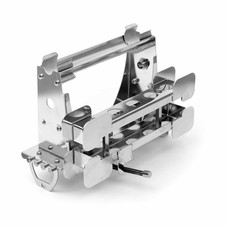
Transport console with grounding ExT-01/2-K-3
It allows you to place the measuring unit, conveniently lay the cable, fix it with a spring clip and place the sensor in the transport pocket. It is equipped with a shoulder strap and a quick-release grounding cable.
Termeks
Tomsk
Produced in: Tomsk
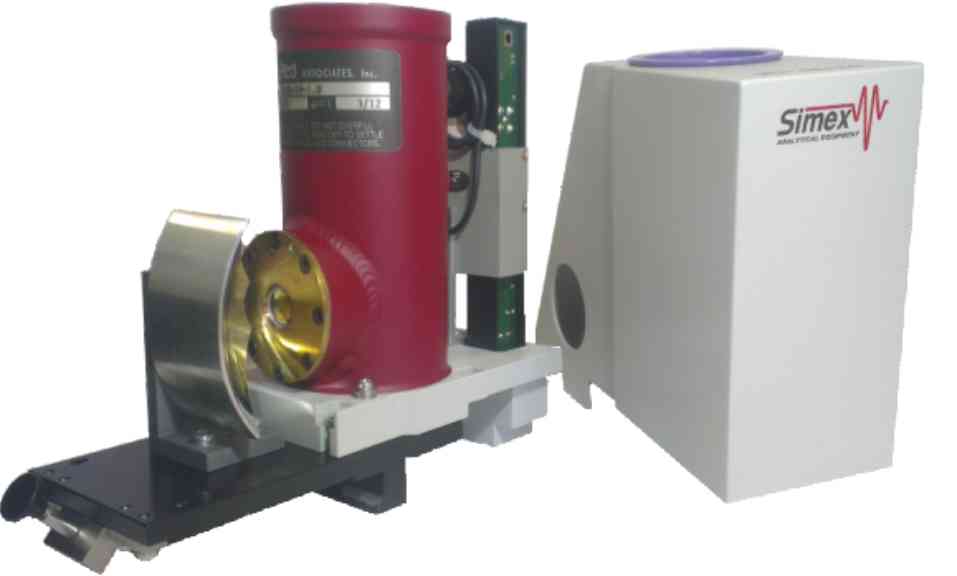
A set-top box with a cooled MST detector
To achieve the maximum sensitivity during measurements, a special prefix is used to the FT-801 Fourier spectrometer, which is an optical unit with a built-in highly sensitive MST detector cooled with liquid nitrogen. The set-top box is installed in the cuvette compartment of the spectrometer and connected to the corresponding external electrical port, the detector is turned on programmatically. In this case, the sensitivity of the method increases many times (up to 20) – depending on the type of standard uncooled detector in the spectrometer). The speed of recording spectra is also increasing. The operating time after filling the cryostat (200 ml capacity) with liquid nitrogen is at least 6 hours.
Increasing the sensitivity of the spectrometer using a prefix with an MST detector may be required for many applications: in fiber spectroscopy, when recording emission spectra of low-power emitters, in trace gas analysis with high spectral resolution, when determining the presence of impurities in samples in ultra-low concentrations, when using multi-pass gas cuvettes, etc.
In the picture: on the left in the cuvette compartment there is a capler with fiber from Art photonics GmbH, Berlin, Germany, on the right there is a prefix with an MST detector.
Technical specifications
The recommended number of scans when registering spectra is 16
Spectrum registration time at 50 scans (resolution 4 cm-1), sec 20
Cryostat capacity, 200 ml
Working time after filling the cryostat, 6 hours
Overall dimensions, mm 225×175×75
Weight, kg 1.45
SIMEKS
Novosibirsk
Produced in: Novosibirsk
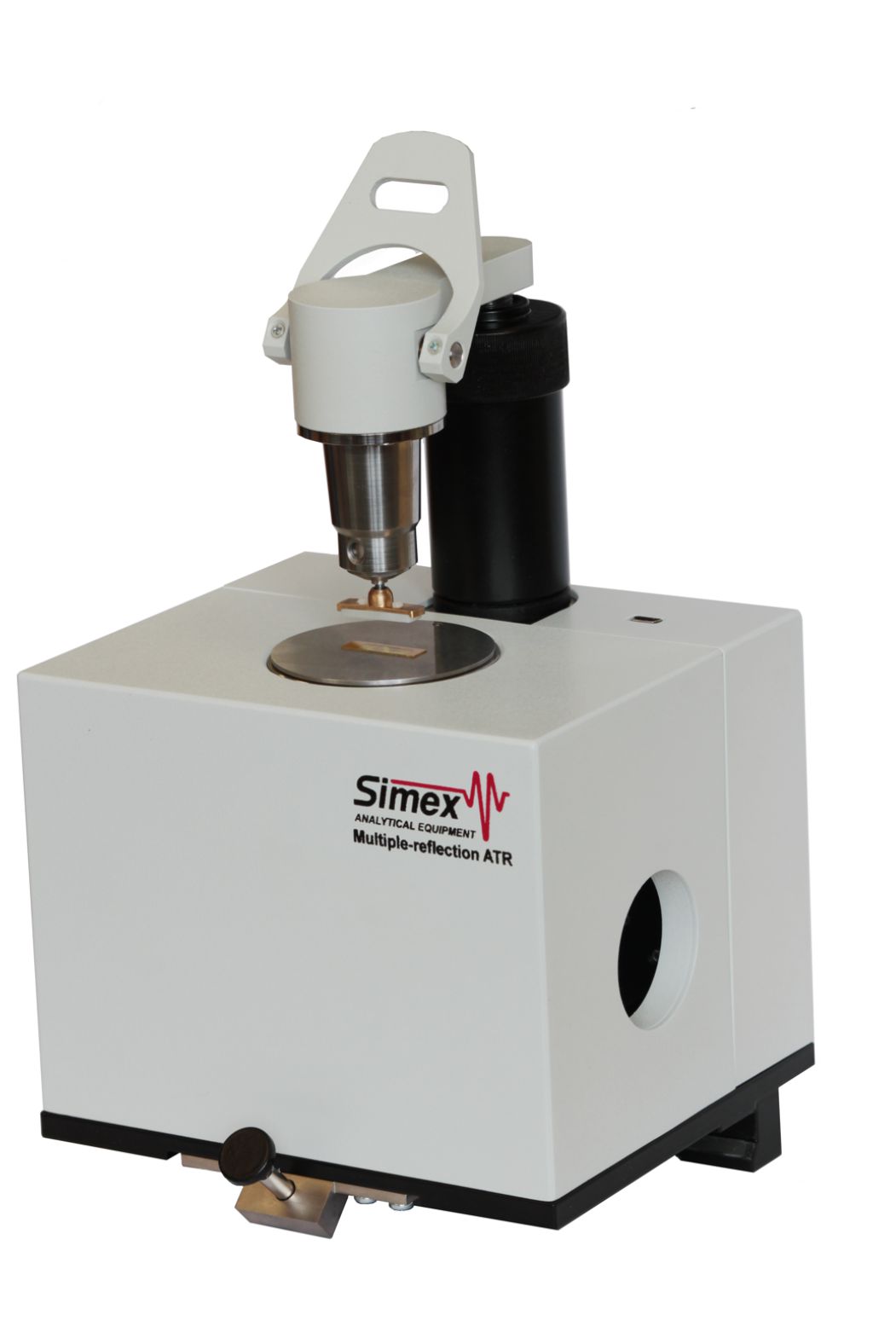
MNPVO prefix with a zinc selenide element and an integrated visualization system on an external monitor
The main difference between this set-top box and the universal set-top box of the NPVO and ZDO is that a prism is used as a working element of the MNPVO, which allows to obtain several reflections from the area of contact with the sample under study, which leads to an improvement in the quality of the spectrum and an increase in the sensitivity of the method (absorption bands become more pronounced). The registration of specular and diffuse reflection spectra (ZDO) is not provided on this set-top box.
The MNPVO prefix is effective in registering the absorption spectra of samples whose dimensions (number) are sufficient to ensure contact with the entire area of the working face of the prism:
* liquids of any degree of viscosity (solutions, suspensions, oils, etc.);
* solid elastic samples (polymer fragments of sufficiently large size, rubbers, plastics, etc.);
* powdered samples in quantities sufficient to be applied to the entire surface and samples in the form of thin tapes;
The universal clamp is equipped with a precision lever mechanism for quickly lowering the tip and a micrometer screw that allows you to pre–set the optimal degree of pressure - this ensures quick sample change and repeatability of the results during measurements. For convenience when working with liquid and paste-like samples, it is possible to rotate the clamping console by 180o.
Note: the MNPVO prefix does not exclude the possibility of registering the spectra of samples whose dimensions are smaller than the area of the working face of the prism (the presence of a visual inspection system of the surface under study increases convenience when working with small-sized objects), but the overall effectiveness of the method is significantly lower than when using the universal NPVO and ZDO prefix.
Transmission in the operating range of the spectrum, % of the input signal of at least 25
· The recommended number of scans when registering spectra is 25
· Spectrum registration time at 25 scans (resolution 4 cm-1), 30 seconds
· The depth of penetration of radiation into the sample, microns 5 – 15
· Minimum area of a solid sample, mm2 1
· Minimum volume of the test liquid, ml 0.3
· The permissible pH range of the analyzed objects is from 5 to 9
· Crystal substrate material ZnSe CVD, Ge
· Diameter of the focus spot, mm 3
· Number of reflections 3
· The size of the working face of the prism, mm 21 X 6
· Magnification of the 4X micro lens
· Total magnification of the visual channel 75X
· Field of view of the optical system, mm 2 X 2.5
· Digital video camera resolution 640 X 480
· Overall dimensions, mm 145×125×240
· Weight, kg 2
SIMEKS
Novosibirsk
Produced in: Novosibirsk

PRIZ - a reflection prefix with the lower position of the sample and visualization of the object under study on the monitor
The main advantage of the PRIZ prefix is the possibility of obtaining well–defined spectra of micro-objects after giving them the shape of a thin layer on mirror-polished metal plates (in the mode of the so-called double passage, when radiation twice penetrates through the layer of matter, reflecting from the mirror-substrate). The presence of a visual control system with a built-in video camera significantly increases the information content when setting up and the reliability of the results obtained. With the help of the prefix, it is also possible to register the reflection spectra of bulk samples and solid objects of arbitrary geometry in native form, including pharmaceuticals in the form of tablets, powders and granules, polymer fragments, LCP, films deposited on the surface.
Technical specifications
Transmission in the operating range of the spectrum, % of the input signal at least 40
The recommended number of scans when registering spectra is 25
Spectrum registration time at 25 scans (resolution 4 cm-1), sec 30
Minimum initial dimensions of a solid sample, mm 0.2 × 0.2
The maximum area of the solid sample, mm 20X20X10
Variable focus range, mm 10
The diameter of the focus spot, mm 3
The angle of incidence of radiation (central beam) on the sample in the ZDO 45o mode
Micro lens magnification / total magnification of the 4X visual channel
Field of view of the optical system, mm 2 X 2.5
The resolution of the digital video camera is 640x480
Overall dimensions, mm 140×105×160
Weight, kg 1.16
SIMEKS
Novosibirsk
Produced in: Novosibirsk
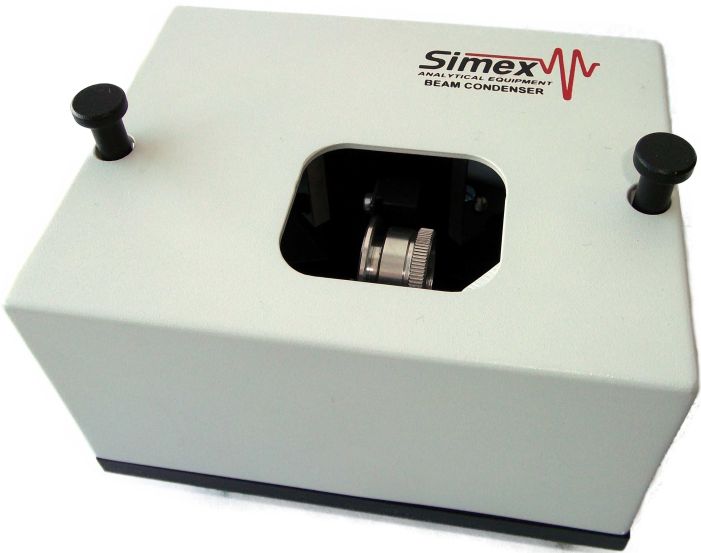
Focusing prefix MKF
It is used in the study of samples compressed into small-diameter tablets with KBr (the method is convenient for spectral analysis of powdery substances - the prefix allows you to work with small amounts of the sample using a manual press for the manufacture of tablets).
• The diameter of the focus spot is less than 3 mm
• Parabolic mirror optics are used in the design
• Windows-substrates can be placed in the prefix after pasty, liquid substances or extracts are applied to them, followed by drying of the layers
• Limited use – in the study of whole samples with dimensions less than 5 mm (preferably using a vertical-type microfocusing attachment)
SIMEKS
Novosibirsk
Produced in: Novosibirsk

Reflection prefix PO-45 V
It is intended for express analysis of various types of solid opaque samples, including polymer films and fragments, paint coatings, finished dosage forms in the form of tablets, optical parts and semiconductor materials.
• The sample is located on the subject plane of the investigated surface downwards, the angle of incidence of the central beam on the sample is 45 °
• The diameter of the focus spot is 3 mm
• Allows you to explore objects of any shape and size
• When using a mini-press, it allows you to examine samples in the form of a thin layer rolled out on a mirror plate made of alloy steel (radiation passes through the substance layer twice, reflecting from the mirror surface)
• Not used: for the study of bulk and liquid substances
SIMEKS
Novosibirsk
Produced in: Novosibirsk
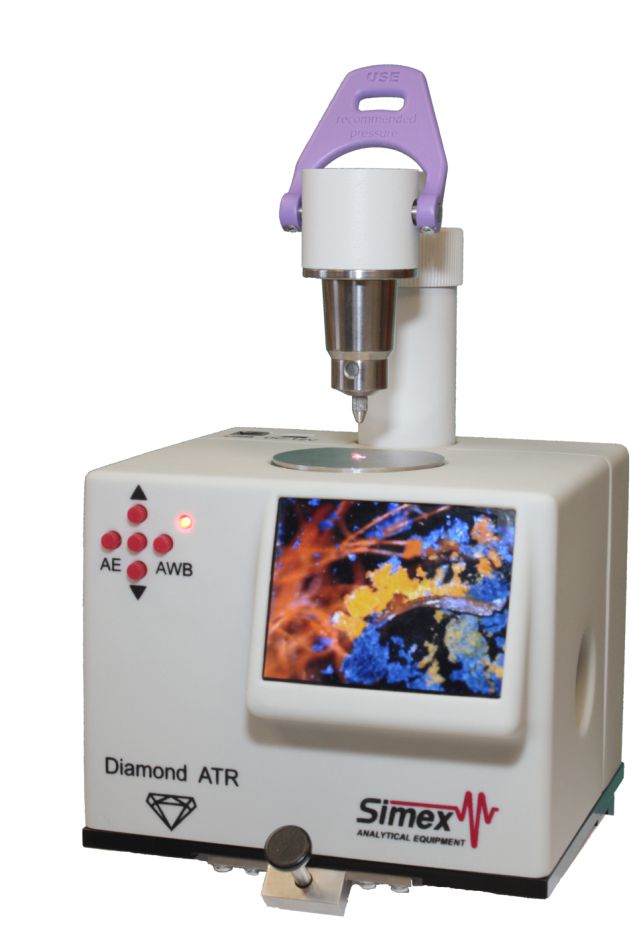
Universal set-top box of NPVO and ZDO with a diamond element and a built-in mini-monitor
It is designed for measurement by the method of disturbed total internal reflection with simultaneous visualization of a micro-object on an integrated and external monitor, as well as by the method of mirror-diffuse reflection with an angle of incidence of 45o at the upper location of the sample.
The prefix in the mode of a single NIP is used to register absorption spectra:
liquids of any degree of viscosity (solutions, suspensions, oils, etc.), including those with high chemical activity;
solid objects of arbitrary shape, including samples with very high hardness (any polymers, fragments of paint coatings, etc.);
powdery substances, including powders with very high hardness (drugs, pharmaceuticals, explosives, inorganic compounds);
samples in the form of thin tapes;
samples in the form of fibers.
The maximum hardness and chemical resistance of the diamond significantly expand the possibilities of the method; there is no need for periodic replacement of the crystal.
The set-top box allows you to register spectra without time–consuming sample preparation, and the presence of a visual inspection system of the studied surface with a high-quality video camera and a built-in high-definition mini-monitor increases efficiency when working with small samples - fragments of thin fibers, microparticles, etc. The built-in monitor has the functions of digital 10X zoom, inverting, etc. The image can be simultaneously displayed on the computer screen (using a USB interface) and then saved as a file.
The removable flange provides a quick and convenient sample change and cleaning of the crystal surface. The design with a diamond element protruding above the base plane of the NPVO allows you to study samples with sufficiently large overall dimensions.
The high quality and repeatability of the results is achieved due to the absence of the influence of the thickness of the substance layer on the shape of the spectrum and the intensity of the absorption bands.
The sample retains its original physicochemical properties and, if necessary, can be further investigated by other methods.
The universal attachment clamp is equipped with a precision lever mechanism for quickly lowering the tip and a micrometer screw that allows you to pre–set the optimal degree of pressure - this ensures quick sample change and repeatability of the results during measurements. For convenience when working with liquid and paste-like samples, as well as in the ZDO mode, it is possible to rotate the clamping console by 180o. The console is equipped with two replaceable tips – with a spherical working part and with a flat hinged head. The high hardness of the diamond allows the use of large clamping forces, which is the determining factor for obtaining high-quality spectra. A replacement table is used to register the specular and diffuse reflection spectra. The sample is located on the subject plane of the investigated surface downwards. The method is used to determine the spectral characteristics of optical parts, thin tapes on the surface, crystals, and other large solid objects of arbitrary shape and size.
SIMEKS
Novosibirsk
Produced in: Novosibirsk
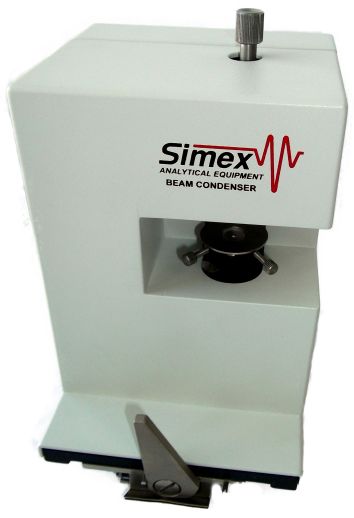
Focusing prefix MKF-Yu
It allows recording transmission spectra of objects with sizes from 500 microns (precious stones, optical parts, semiconductor materials).
It is also used in the study of samples compressed into small-diameter tablets with KBr (the method is convenient for spectral analysis of powdery substances - the prefix allows you to work with small amounts of the sample using a manual press for the manufacture of tablets).
• The diameter of the focus spot is less than 3 mm
• The design uses parabolic mirror optics
• The set-top box is equipped with a set of replaceable diaphragm holders for samples of different sizes
• Windows-substrates made of IR-transparent materials can be placed in the holder after pasty, liquid substances or extracts are applied to them, followed by drying of the layers
• The slide table has the possibility of smooth movement in vertical and horizontal directions to achieve the maximum signal level
SIMEKS
Novosibirsk
Produced in: Novosibirsk
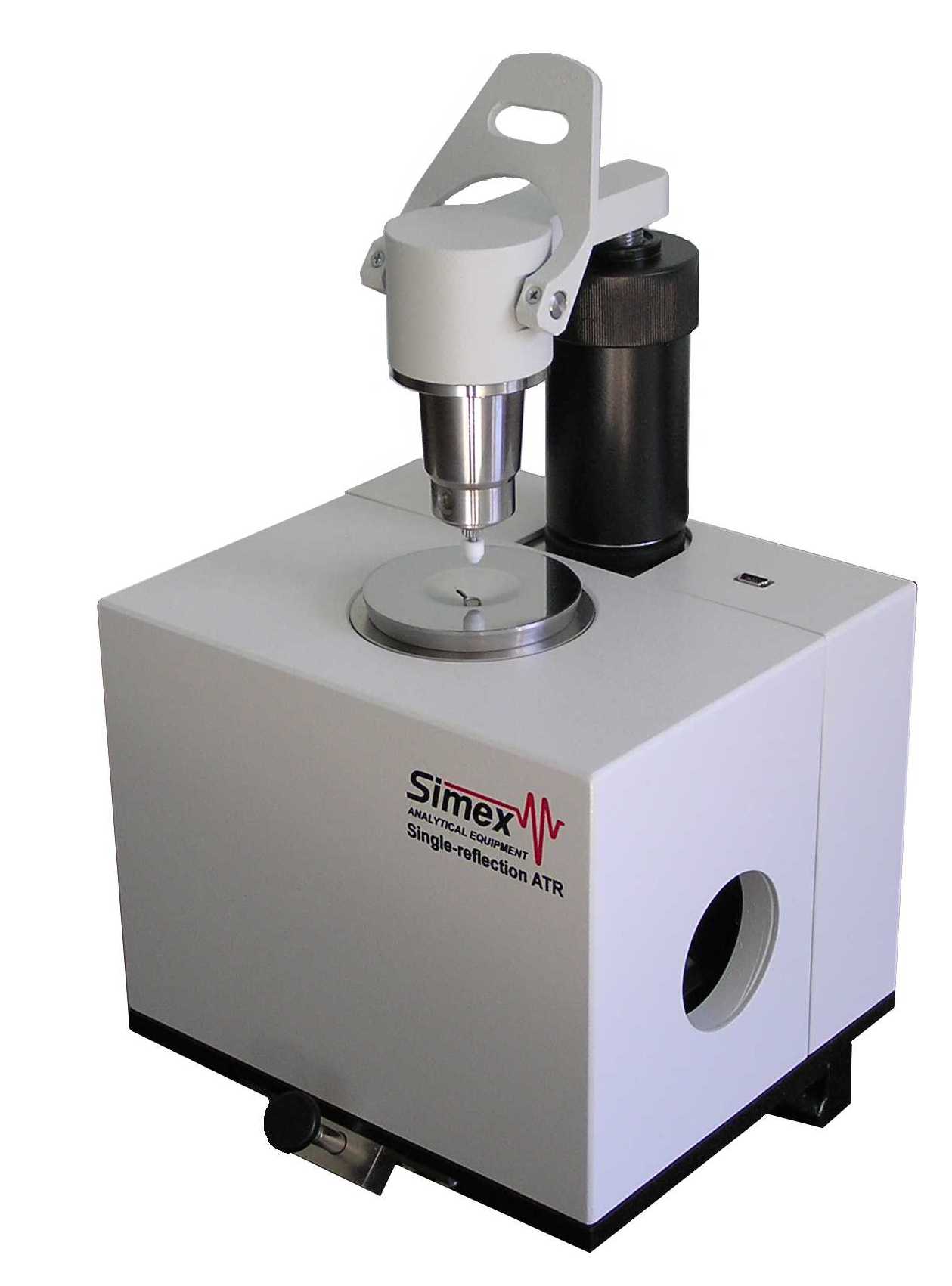
Universal optical set-top box with zinc selenide element and integrated visualization system on an external monitor
It is intended for express analysis of various types of solid and liquid samples, including polymer particles, films and fibers, powdery substances, fragments of paint coatings, fuels and lubricants. The presence of an optical system for visual inspection of the surface under study with an increase of 75X ensures high efficiency when working with small samples – fragments of thin fibers, microparticles, etc. The universal clamp is equipped with a precision lever mechanism for quickly lowering the tip and a micrometer screw that allows you to pre–set the optimal degree of pressure - this ensures quick sample change and repeatability of the results during measurements. For convenience when working with liquid and paste-like samples, as well as in the ZDO mode, it is possible to rotate the clamping console by 180o. The console is equipped with two replaceable tips – with a spherical working part and with a flat hinged head.
A replacement table is used to register the specular and diffuse reflection spectra. The sample is located on the subject plane of the investigated surface downwards, the angle of incidence of the central beam on the sample is 45 °. The method is used to determine the spectral characteristics of optical parts, crystals, thin films on the surface, as well as to register the absorption spectra of large solid objects.
Transmission in the operating range of the spectrum, % of the input signal at least 30
The recommended number of scans when registering spectra is 25
Spectrum registration time at 25 scans (resolution 4 cm-1), sec 30
The depth of penetration of radiation into the sample, microns 5 – 15
Minimum area of a solid sample, mm 0.2 × 0.2
Minimum volume of the liquid under study, ml 1
Minimum dimensions of the fiber sample: cross-section diameter/length, mm 0.1/1
Substrate crystal material ZnSe CVD, Ge
Focusing spot diameter, mm 1
The angle of incidence of radiation (central beam) on the sample in the ZDO mode 45o
Magnification of the micro lens / total magnification of the visual channel 4X /75X
Field of view of the optical system, mm 2 X 2.5
Digital video camera resolution 640 X 480
Overall dimensions, mm 150×150×260
Weight, kg 2.15
• Allows you to study objects of small size (from 200 microns - depending on the geometry, surface quality and physico-chemical properties of the material)
• The attachment allows you to work without sample preparation, has a fixed adjustment of the pressure on the sample using a clamp equipped with color indicators
• Thanks to the removable flange with the NPVO element, a quick and convenient sample change and cleaning of the crystal surface is provided
• At a given optimal contact force, the method provides high quality and repeatability of results due to the absence of influence of the thickness of the substance layer on the shape of the spectrum and the intensity of the absorption bands
• The sample retains its original physical and chemical properties and, if necessary, can be further investigated by other methods
SIMEKS
Novosibirsk
Produced in: Novosibirsk
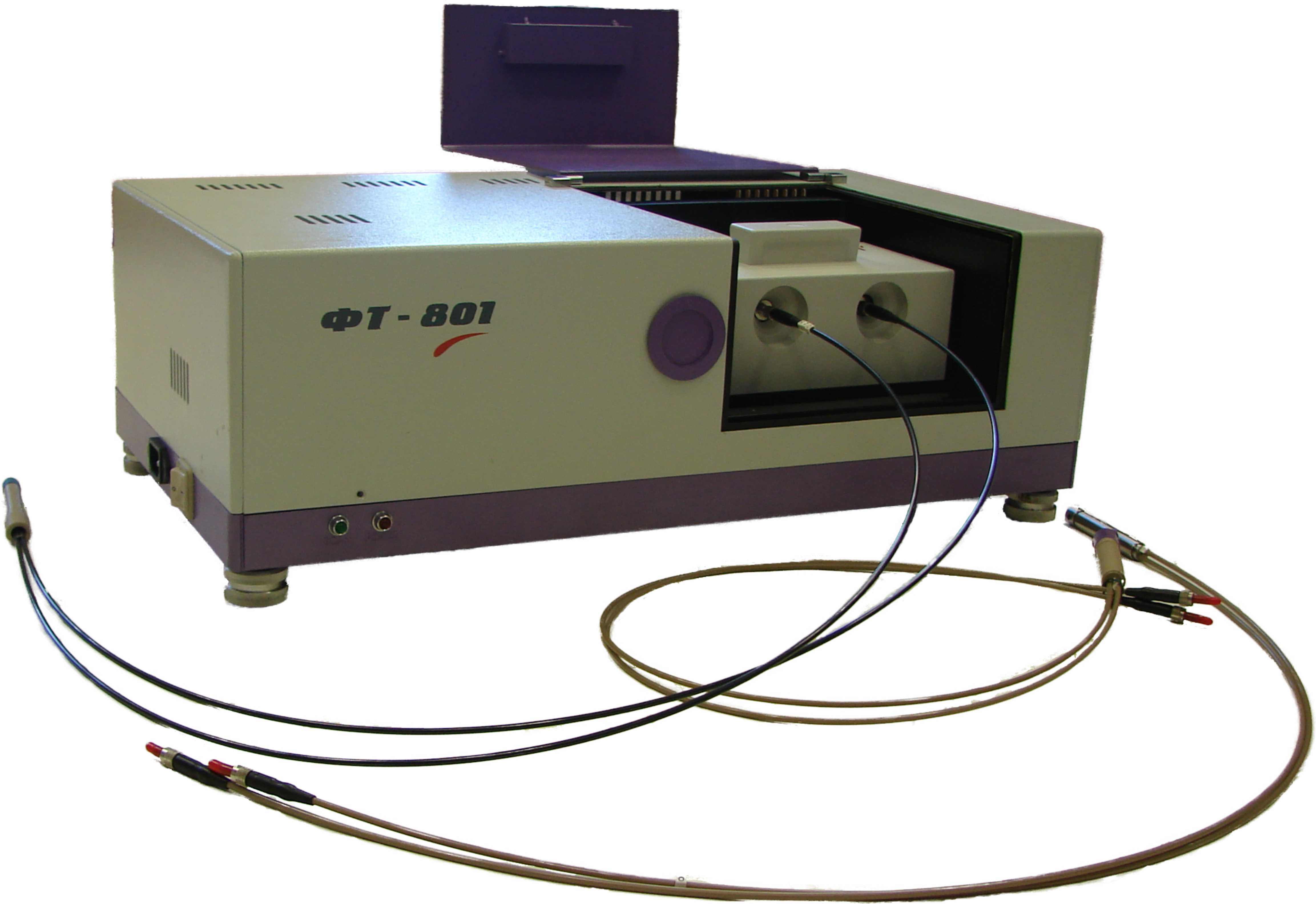
Optical set-top box for working with light-guide IR probes
FT-801 IR Fourier spectrometers can additionally be equipped with a special optical set-top box that allows efficient use of light-guide systems.
4 types of light-guide probes allow measuring transmission and reflection spectra in solid, liquid and gaseous media
Modern IR light guides have high intrinsic transmittance and sufficient mechanical strength, which makes it possible to transfer measurements from the laboratory directly to production - to control the flow of technological processes, check the quality of raw materials and finished products.
Application areas:
· Chemical and microbiological industry
· Pharmaceutical industry
· Medicine and Cosmetology
· Food industry
· Petroleum products, fuels and lubricants
· Criminology
SIMEKS
Novosibirsk
Produced in: Novosibirsk
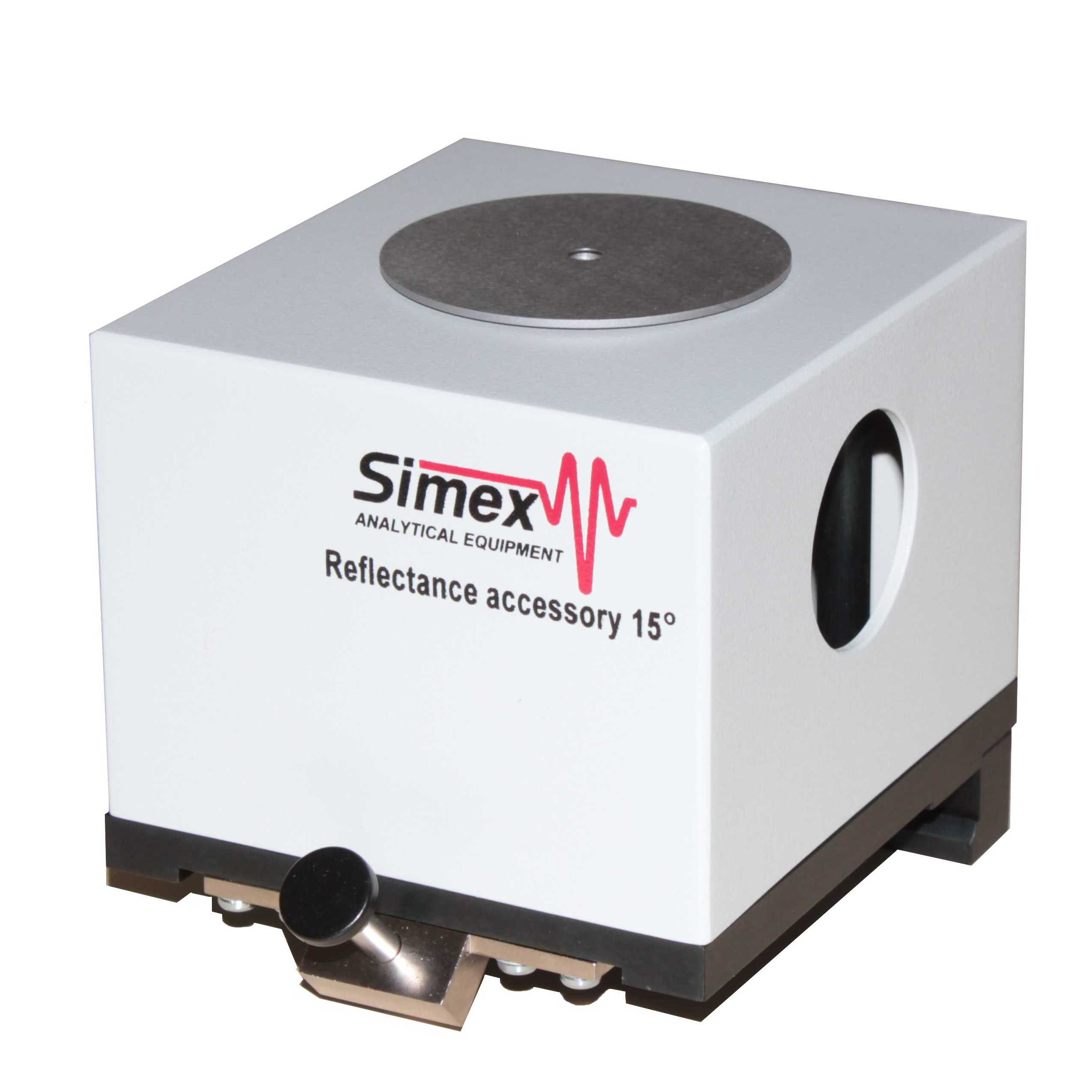
Reflection prefix PO-15 V
Designed for the study of various types of solid samples, including optical and semiconductor materials, precious stones and other objects of arbitrary shape
• The sample is located on the subject plane of the investigated surface downwards, the angle of incidence of the central beam on the sample is 15 °
• Allows you to examine samples of small sizes (the diameter of the test area is from 1 mm)
• The set-top box is equipped with a set of replaceable diaphragm holders for samples of different sizes
• When using a mini-press, it allows you to examine samples in the form of a thin layer rolled out on a mirror plate made of alloy steel (radiation passes through the substance layer twice, reflecting from the mirror surface)
• Not used: for the study of bulk and liquid substances
SIMEKS
Novosibirsk
Produced in: Novosibirsk
